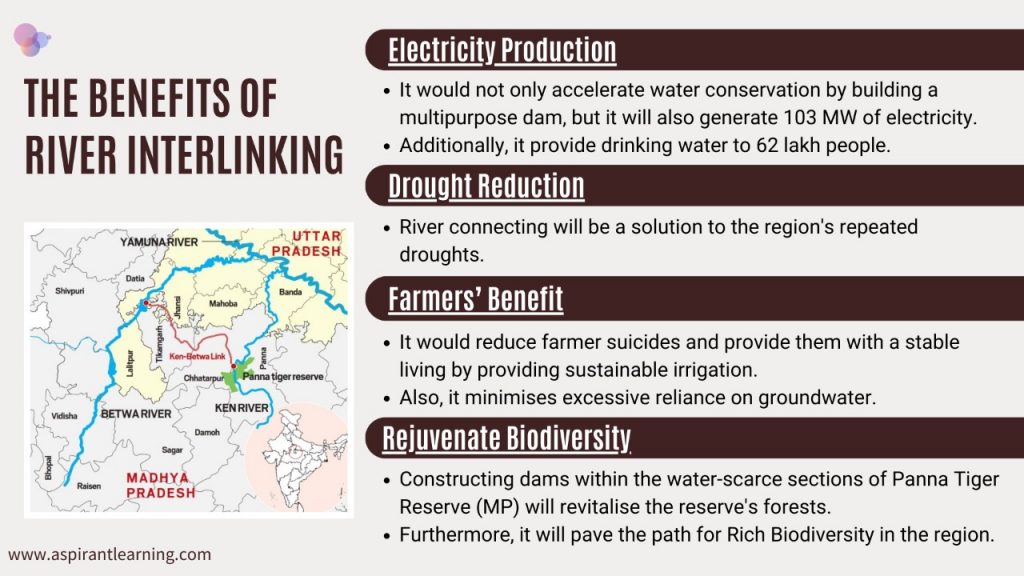News Highlight
An agreement signed this week paves the way for implementing the Ken-Betwa Link Project in drought-prone Bundelkhand.
Key Takeaway
- The Ken-Betwa Link Project (KBLP) Steering Committee met for the third time on January 18 in New Delhi.
- It was presided over by the Secretary of the Ministry of Jal Shakti’s Department of Water Resources.
- He stated that KBLP was a “flagship” project of the national government and that it “is vital for the water security and socio-economic development of Bundelkhand region”.
Ken-Betwa Link Project (KBLP)
- About
- The Ken-Betwa Link Project is the first in the National Perspective Plan (NPP) for river interconnection.
- The project entails transferring excess water from the Ken river in Madhya Pradesh’s Panna district to the Betwa river in Uttar Pradesh.
- Both of these rivers are tributaries of the Yamuna River.
- This will be accomplished by constructing the Dhaudan Dam and a 221-kilometre-long canal.
- The proposal requires permission the share funds from the Centre and the State.
- As well as the formation of a new organisation, the Ken Betwa Link Project Authority, to carry out the project.
Significance of the Project
- It would offer drinking water to 41 lakh people in Madhya Pradesh and 21 lakh people in Uttar Pradesh.
- This project also includes a hydropower component that will generate slightly more than 100 MW of electricity.
- The project will be highly beneficial to Bundelkhand’s water-stressed region.
- The Bundelkhand region would receive irrigation water as well as power.
- It will open the way for further river project interconnections to ensure that water scarcity does not impede the country’s development.
Challenges of the Project
- Ecological impact
- The National Board for Wildlife (NBWL) has expressed significant worries about the probable ecological damage caused by the project.
- Submergence
- The project will partially submerge Madhya Pradesh’s Panna Tiger Reserve, affecting the habitat of vultures and jackals.
- However, after years of complaints, the primary wildlife regulator, the National Board for Wildlife, finally approved it in 2016.
- Disagreement between the states
- The two states needed help to agree on how to divide water, especially during the non-monsoonal months.
- The friendly atmosphere may not remain forever, and disagreements may occur when rival parties form governments in Lucknow and Bhopal.
- High Cost
- Project installation and upkeep are expensive.
- The Comprehensive Detailed Project Report estimates the cost of the Ken-Betwa Link Project at Rs 35,111.24 crore in 2017-18 pricing.
National Perspective Plan (NNP)
- About
- In August 1980, the Ministry of Irrigation created a National Perspective Plan (NNP) for water resource development in the country, which included inter-basin water transfer.
- The NPP consisted of two parts:
- Peninsular Rivers Development
- Himalayan Rivers Development.
- The National Water Development Agency (NWDA) recognised 30 river linkages based on the NPP, 16 under the Peninsular Component and 14 under the Himalayan Component.
- The Peninsular component includes 16 river connection projects, including the Ken Betwa Link Project.
Ken River
- The Ken River begins near the village of Ahirgawan on the northwest slopes of the Kaimur Range in the Jabalpur district.
- It flows for 427 kilometres before joining the Yamuna.
Betwa River
- It rises immediately north of Hoshangabad, Madhya Pradesh, in the Vindhya Range.
- The Betwa River flows 654 kilometres from its headwaters near Bhopal, Madhya Pradesh, to its merging with the Yamuna.

Way Forward
- The necessity and practicality of river interlinking should be evaluated case-by-case, emphasising resolving national issues.
- In the water industry, establish public-private partnerships and modify water pricing to recoup at least operation and maintenance costs.
- A community-based method to encourage behavioural changes and community involvement in groundwater management.
Pic Courtesy: News18
Content Source: The Hindu



